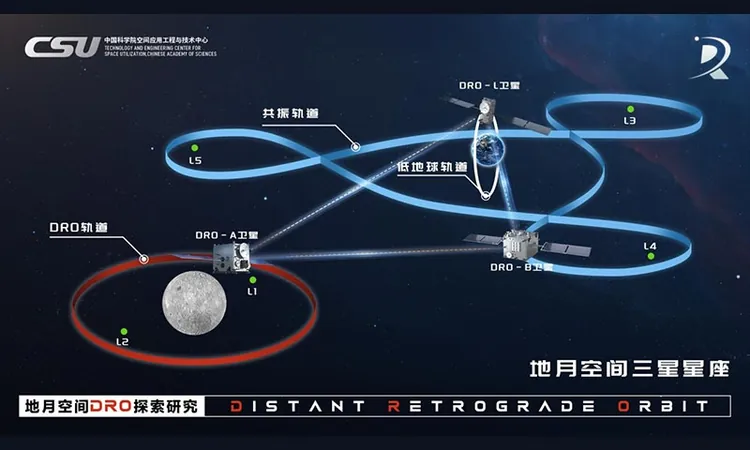
China Launches Revolutionary Three-Satellite Constellation in Cislunar Space!
2025-04-16
Author: Siti
China Achieves a Historic Milestone in Space Exploration
In an extraordinary feat, China has successfully established the **world's first three-satellite constellation** in the groundbreaking **distant retrograde orbit (DRO)** within the Earth-moon region. This development, reported by China Central Television (CCTV), is poised to revolutionize our understanding of space.
The Vast Potential of Cislunar Space
The Earth-moon region, extending up to 2 million kilometers from Earth, represents a **massive frontier for exploration**—its three-dimensional volume is more than a thousand times that of traditional orbital space. The Chinese Academy of Sciences (CAS) emphasizes that harnessing this cislunar area holds **strategic significance** for everything from lunar resource exploitation to sustainable interplanetary travel.
The Journey to the DRO Begins
Launched in **2024**, the initial satellites—DRO-A, DRO-B, and DRO-L—were the culmination of years of research, beginning with preliminary studies in **2017**. The pioneering pilot project aimed to explore the unique characteristics of the DRO and its application potential, positioning China at the forefront of lunar and space science.
Cost-Effective Access to Cislunar Space!
Chinese scientists achieved a **historic breakthrough** by successfully performing a low-energy insertion into the DRO using just **one-fifth** of the fuel required by conventional methods. This innovation not only slashes costs but also opens **new avenues** for future large-scale projects in cislunar space.
Unprecedented Communication Innovations
In a further leap forward, the constellation has verified a **1.17-million-kilometer K-band inter-satellite microwave communication link**. This is a world-first accomplishment that effectively overcomes previous technological barriers, allowing for scalable and efficient satellite networks in cislunar space.
Advancements in Space Science
The mission also supports **advanced astrophysical research**, including gamma-ray burst detection, and tests cutting-edge technologies like atomic clocks. Notably, researchers launched a revolutionary orbit determination system that allows one satellite to track another, achieving accuracy comparable to days of conventional tracking—using only three hours of inter-satellite data!
Paving the Way for the Future of Space Exploration
As articulated by Wang Wenbin from CAS, this achievement signifies an international first: using satellite-to-satellite tracking instead of ground stations for orbit determination. This breakthrough is set to reshape future lunar exploration, offering an efficient pathway for navigation and timing—crucial for the expected surge in **commercial activities** in cislunar space.
With these advancements, China is not just leading the charge in space exploration but is also laying a foundation for a future where humanity can explore, inhabit, and thrive beyond our planet.

 Brasil (PT)
Brasil (PT)
 Canada (EN)
Canada (EN)
 Chile (ES)
Chile (ES)
 Česko (CS)
Česko (CS)
 대한민국 (KO)
대한민국 (KO)
 España (ES)
España (ES)
 France (FR)
France (FR)
 Hong Kong (EN)
Hong Kong (EN)
 Italia (IT)
Italia (IT)
 日本 (JA)
日本 (JA)
 Magyarország (HU)
Magyarország (HU)
 Norge (NO)
Norge (NO)
 Polska (PL)
Polska (PL)
 Schweiz (DE)
Schweiz (DE)
 Singapore (EN)
Singapore (EN)
 Sverige (SV)
Sverige (SV)
 Suomi (FI)
Suomi (FI)
 Türkiye (TR)
Türkiye (TR)
 الإمارات العربية المتحدة (AR)
الإمارات العربية المتحدة (AR)